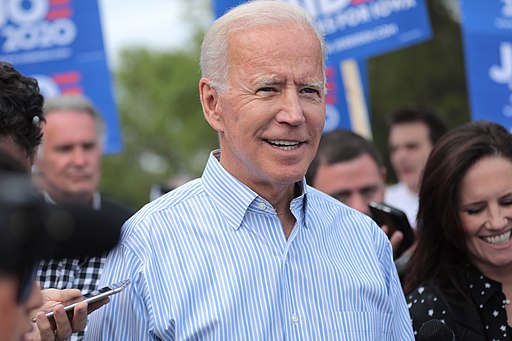Search
Five ways that a Biden presidency may reshape employment law and HR-compliance

Gage Skidmore from Peoria, AZ, United States of America, CC BY-SA 2.0, via Wikimedia Commons
Once the networks called the presidential election for Joe Biden over the weekend, something dawned on me. Maybe, I should write about how the new administration may impact employment law.
I mean, what other employment lawyer/blogger would think to do that? Dibs!
So, since no one else in the entire world will be writing about this topic today, keep it here as I share five ways in which employment law could change over the next four years.
But before I get to the first change, I’m going to try to get ahead of what I anticipate are some emails from unhappy readers.
Nearly half of all voters cast their ballot for President Trump. So, I understand that there may be some hurt feelings. Plus, the result of the presidential election is not ‘official’ yet. I get it. You don’t need to remind me. I’m not trying to dunk on anyone. This post is nonpartisan.
Indeed, if President Trump continues as president through 2024, I will do a follow-up post about how the current administration could continue to impact employment law.
Change No. 1 – Higher wages and equal treatment.
According to the Biden Plan, the federal minimum wage would increase from $7.25/hour to $15/hour.
Additionally, President-elect Biden supports the Paycheck Fairness Act, about which I have blogged before (here). When Congress amended the Fair Labor Labor Standards Act in 1963, it included equal-pay provisions. These equal-pay provisions make it unlawful for an employer to pay men and women doing the same or similar work differently — unless the employer can demonstrate that it based the pay differential on “any other factor other than sex.” The Paycheck Fairness Act would strike “any other factor other than sex” and insert “a bona fide factor other than sex, such as education, training, or experience.”
Change No. 2 – Mandatory anti-harassment training and other related prophylactic measures.
I’ve written about President Trump’s “Executive Order on Combating Race and Sex Stereotyping” many times. Under the EO, government contractors cannot use any workplace training “that inculcates in its employees any form of race or sex-stereotyping or any form of race or sex scapegoating” and provides several examples of specific concepts that would be prohibited in such training programs.
So, concepts like “white privilege” and “critical race theory” are now taboo. President-elect Biden will rescind that EO.
Beyond that, President-elect Biden supports the Bringing an End to Harassment by Enhancing Accountability and Rejecting Discrimination in the Workplace (BE HEARD) Act. Among other things, the BE HEARD Act would require most businesses to have anti-harassment policies and training. It would also codify the outcome of Bostock v. Clayton County to make clear that Title VII prohibits discrimination based on sexual orientation, gender identity, pregnancy, childbirth, a medical condition related to pregnancy or childbirth, and a sex stereotype.
Change No. 3 – The National Labor Relations Board pendulum will swing back for workers.
The National Labor Relations Board is “an independent federal agency vested with the power to safeguard employees’ rights to organize and to determine whether to have unions as their bargaining representative. The agency also acts to prevent and remedy unfair labor practices committed by private sector employers and unions.”
The Board can have up to five members, and the President appoints Board Members to five-year terms, with Senate consent, the term of one Member expiring each year. Generally, when the Board has more Republicans than Democrats, the rulings tend to favor employers. Conversely, worker rights improve when the Democrats control the Board.
Currently, the Board has four members, three Republicans and one Democrat. The most recent appointee is a Democrat, Lauren McFerran. The five-year term of William Emanuel (R) expires next year. Expect President-elect Biden to fill Mr. Emanuel’s seat with a Democrat and the empty one too.
Come fall of 2021, expect changes in joint-employment standards, fewer employee-confidentiality restrictions on workplace investigations, weakening of employer property rights (e.g., employees using company e-mail to organize), and limits on arbitration provisions, among other things.
Change No. 4 – The EEOC will look different too…eventually.
Since September 30, 2020, there have been three new EEOC Commissioners. Now, all five seats are filled (three Republicans and two Democrats). The next seat to open up will be Jocelyn Samuels (D). Presumably, she will stick around for another term. Next is Chair Janet Dhillon (R), but not until July 2022. Presumably, the Democrats will assume control then.
In the interim, the EEOC is considering rule changes to its conciliation process and wellness programs. The EEOC has also put the kibosh (for now) on collecting of EEO-1 Component 2 data. Plus, we’re WAY overdue on sexual harassment guidance.
Change No. 5 – Pregnancy accommodations.
Back in September, the House passed the Pregnant Workers Fairness Act (PWFA) by a vote of 329-73. The Dems controlled the House, but not by that much. Additionally, the U.S. Chamber of Commerce supports the legislation. SHRM and the ACLU support it too.
I imagine that, aside from President-elect Biden nixing the Executive Order on Combating Race and Sex Stereotyping, this will be the first meaningful change that happens, especially with bipartisan support.
 The Employer Handbook Blog
The Employer Handbook Blog


